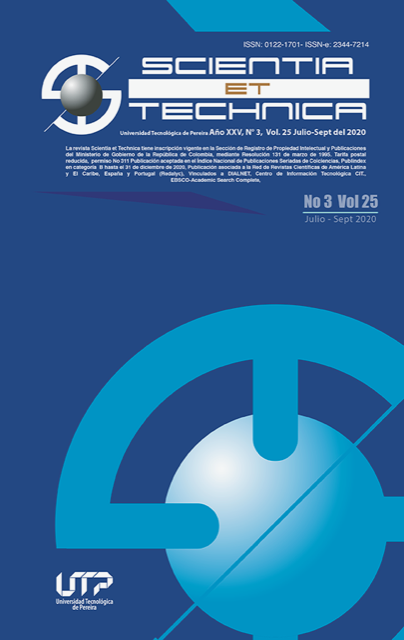Neuromatemática un estudio interdisciplinario: el caso de las emociones expresadas en la construcción del paralelepípedo
DOI:
https://doi.org/10.22517/23447214.24751Palabras clave:
APOE, Didáctica de la Matemática, Emociones, Microexpresiones Faciales, Neurociencia, Neurodidáctica, NeuromatemáticaResumen
La presente investigación propone un estudio interdisciplinario entre la Neurociencia y la Didáctica de la Matemática a través de dos constructos de estos campos –las emociones y la Teoría APOE (acción, proceso, objeto y esquema)–. Desde lo metodológico se ha seleccionado el binomio emoción y solución de problemas geométricos, en estudiantes de quinto de primaria, con la finalidad de mostrar las emociones que emergen cuando ellos construyen un paralelepípedo con el software Cabri 3D a través de rectas en etapas de la construcción cognitiva de acción, proceso, objeto y esquema. Los resultados obtenidos derivan de un análisis de tres fuentes: (1) Detección de microexpresiones faciales, (2) Mapa de calor y (3) Prueba de Tukey, las que tributan a sostener que esta relación de la teoría APOE en concordancia con lo que la Neuromatemática nos señala sobre las emociones, fundamenta los procesos pedagógicos y didácticos dados en la enseñanza y aprendizaje de la geometría.
Descargas
Citas
[2] D. Redolar, "Neurociencia: la génesis de un concepto multidisciplinar", vol. 29(6), Barcelona: Rev Psiquiatría Fac Med Barna, 2002, pp. 346-352.
[3] C. Escera, "Aproximación historica y conceptual a la neurociencia cognitiva", Revista cognitiva, vol. 16, Barcelona: Fundación Infancia y Aprendizaje, 2004, pp. 1-20.
[4] J. Fuster, "CEREBRO Y LIBERTAD", Barcelona: Ariel, 2014, pp. 1-375.
[5] J. Fuster, "Cortex and Mind: Unifying Cognition", Nueva York: Oxford University Press, 2003.
[6] M. Bejar, "Una mirada sobre la educación, neuroeducación. Padres y Maestros", Madrid: Universidad Pontificia Comillas, 2014, pp. 49-52.
[7] F. Mora, "Neurocultura. Una cultura basada en el cerebro", Madrid: Alianza, 2007, pp. 1-178.
[8] R. Paterno, "Neurocultura". hallado por Meléndez (2009) en http:/www.plandecenal.edu.co/comunidades, [Accedido: 7-feb-2018], 2008.
[9] L. Meléndez, "Neurodidáctica y el desarrollo de las funciones ejecutivas". VIII Congreso Educativo: El sentido de la Educación en un Mundo en Crisis. Universidad Interamericana de Costa Rica. Recuperado de:, https://nanopdf.com/download/neurodidactica-y-el-desarrollo-de-las_pdf: [Accedido:19-abril-2020], 2009.
[10] J. Gascón, "Evolución de la didáctica de las matemáticas como disciplina científica, Recherches en didactique des Mathématiques, 1998, pp. 7-33.
[11] A. D. M. Immordino-Yang, “We Feel, Therefore We Learn: The Relevance of Affective and Social Neuroscience to Education”, Brain: Education, 2007, pp. 3-10.
[12] L. Vygotsky, "Teoría de la Emociones. Estudio Histórico-Psicológico", Madrid: AKAL, 2004, pp. 1-260.
[13] E. Dubisnsky, "Reflective Abstraction in Advanced Mathematical Thinking", Dordrecht: DO Tall, 1991, pp. 95-123.
[14] L. Zabala-Jaramillo, "Construcciones y Mecanismos mentales para implementar y desarrollar el concepto de los vectores en tres dimensiones (3D) mediante el apoyo de la herramienta Cabri para el cálculo de volúmenes". Tesis Doctoral, Valparaíso: Pontificia Universidad Católica de Valparaíso, 2015.
[15] P. Ekman., "Universal Facial Expression of Emotion", vol. 8, California: Mental Health Rsearrch Digest, 1970, pp. 151-158/.
[16] P. Ekkman y W. Friesen, "A new pan-cultural facial expression of emotion. Motivation and Emotion", vol. 10, Los Angeles, 1986, pp. 159-168.
[17] J. Fauter, "Cerebro y Libertad", Barcelona: Ariel, 2014.
Descargas
-
Vistas(Views): 748
- PDF Descargas(Downloads): 380
Publicado
Cómo citar
Número
Sección
Licencia
Derechos de autor y licencias
La revista es de acceso abierto gratuito y sus artículos se publican bajo la licencia Creative Commons Atribución/Reconocimiento-No Comercial-Compartir bajo los mismos términos 4.0 Internacional — CC BY-NC-SA 4.0.
Los autores de un artículo aceptado para publicación cederán la totalidad de los derechos patrimoniales a la Universidad Tecnológica de Pereira de manera gratuita, teniendo en cuenta lo siguiente: En caso de que el trabajo presentado sea aprobado para su publicación, los autores deben autorizar de manera ilimitada en el tiempo, a la revista para que pueda reproducirlo, editarlo, distribuirlo, exhibirlo y comunicarlo en cualquier lugar, ya sea por medios impresos, electrónicos, bases de datos, repositorios, discos ópticos, Internet o cualquier otro medio requerido.
Los cedentes mediante contrato CESIÓN DE DERECHOS PATRIMONIALES declaran que todo el material que forma parte del artículo está totalmente libre de derechos de autor de terceros y, por lo tanto, se hacen responsables de cualquier litigio o reclamación relacionada o reclamación relacionada con derechos de propiedad intelectual, exonerando de toda responsabilidad a la Universidad Tecnológica de Pereira (entidad editora) y a su revista Scientia et Technica. De igual forma, los autores aceptan que el trabajo que se presenta sea distribuido en acceso abierto gratuito, resguardando los derechos de autor bajo la licencia Creative Commons Atribución/Reconocimiento-No Comercial- Compartir bajo los mismos términos 4.0 Internacional — CC BY-NC-SA 4.0.
https://creativecommons.org/licenses/by-nc-sa/4.0/
A los autores, la revista Scientia et Technica tiene la obligación de respetarle los derechos morales (artículo 30 de la Ley 23 de 1982 del Gobierno Colombiano) que se les debe reconocen a estos la paternidad de la obra, el derecho a la integridad y el derecho de divulgación. Estos no se pueden ceder ni renunciar.



